Have you had your annual Halloween playthrough of Ravenloft yet? It's one of my favorite Halloween traditions. If you haven’t ever had a D&D Halloween mega-party and battled your way through the halls of Castle Ravenloft with the sole objective of destroying Count Strahd von Zarovich, then you need to wrangle your friends and try it!
Your goal is to create a scenario in which it’s possible for the heroes to kill Strahd von Zarovich in a single session of play. This means that, instead of preparing all of Curse of Strahd, you will only need to prepare Fortunes of Ravenloft from chapter 1 and Castle Ravenloft from chapter 4 of the adventure. Ravenloft is a large place, and exploring it thoroughly isn’t really possible in a single sitting. You will have to make a few changes in order for the characters to fight Strahd before the night ends or people get exhausted. I’ll include the changes and optional rules I use to run Ravenloft as a one-shot adventure, but feel free to mix and match these rules to suit your table.
Make Prep Easier With Maps!
All maps and creatures from Curse of Strahd are now in Maps, and a new top-down layout of Castle Ravenloft is also available!
With D&D Beyond’s Maps tool, Dungeon Masters can quickly create in-game maps from the sourcebooks they own on D&D Beyond and populate them with creature and player tokens.
Some Assembly Required
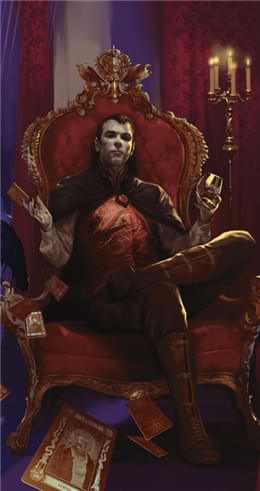 To battle Strahd in a single night, all you need is a copy of Curse of Strahd and 3 to 6 friends to play with. Some things that will make your play session easier and more exciting include:
To battle Strahd in a single night, all you need is a copy of Curse of Strahd and 3 to 6 friends to play with. Some things that will make your play session easier and more exciting include:
- A tarokka deck.
- A map of Castle Ravenloft found in chapter 4 of the adventure. However, while stylish, this map is famously hard to use as a battle map. There is a more user-friendly top-down layout of Castle Ravenloft available in D&D Beyond's Maps tool, which is available to Master-tier subscribers.
- Pregenerated characters. If you want your game to be easy to pick up and play, you might want to create enough pregenerated characters for your whole group, since time is of the essence for this dungeon delve.
- A 60-minute hourglass. This is perhaps the most luxurious optional item, but boy is it fun. More on this below.
One-Session Ravenloft Rules
This is not a normal session of D&D. Unless you have friends who could play D&D from dawn to dusk, you will most likely need to impose a concrete and — if we’re being honest with ourselves — arbitrary time limit upon the adventure. For most groups, the maximum amount of time they can commit to playing D&D is about 4 hours. To that end, I created some rules and limitations that turn this exploration of Castle Ravenloft into a deadly race against the clock.
Countdown to the Count
In the past, I’ve struggled to run Ravenloft in a single game session. It’s too big for a one-shot game, especially if your players really want to explore the castle and soak in all the details. My ideal D&D game lasts about 4 hours … or enough time to explore and appreciate about a half of the castle, in my experience.
If you like a 4-hour game of D&D, then “Strahd Must Die Tonight” has a four-hour real-life time limit (plus the half hour or so it takes to fight Strahd). I like to have Strahd appear before them in person as they enter the castle and declare that they have “four hours until planar midnight,” which sidesteps the issue of game time passing differently than in real-time. Once the four hours are up, Strahd immediately appears before the party and attacks. Come life or come death, the hunt ends here.
Bestowing Gifts on the Adventures
At the end of every real-life hour, Strahd appears before the party and mocks the party, pitying their inevitable defeat. He offers to bestow a random gift upon one of the characters, determined from the table below — if that character allows Strahd to bite them and drink their blood first (Strahd makes a single Bite attack against the volunteer that always hits). These gifts are designed to speed up play by goading the players into rash action. If you feel an event would drag the game down, you can replace it.
Why does Strahd give these gifts? The same reason he’s set a time limit at all: he’s toying with the characters like a cat toys with a mouse. He believes himself invincible… until any character finds the Sunsword. Once he knows this item has been found, his hourly taunting visits are replaced with hourly surprise attacks against the character wielding the blade. He materializes from thin air, strikes, then flees using his Shapechanger trait as quickly as possible.
Having a 60-minute hourglass at the table that you use to track time at the table instead of a digital timer makes this adventure particularly memorable, dramatic, and campy. The players can see their time trickling away before their very eyes — and you can make a big show of tipping it over again once Strahd appears. It makes me feel like the Wicked Witch of the West taunting Dorothy with how long she has left to live.
Strahd Random Event Table
The following effects only function while within Castle Ravenloft.
|
1d8 |
Event |
|---|---|
|
1 |
One melee weapon of the character’s choice in their possession deals an extra 2d6 radiant damage against all undead except Strahd. |
|
2 |
The character’s damage-dealing cantrips deal an extra 2d6 radiant damage against all undead except Strahd. |
|
3 |
The character regains 2d6 hit points whenever they kill a living creature with blood in its body. |
|
4 |
The character and up to six other creatures that they are touching can teleport to the castle’s Chapel (area K15) by spending 10 minutes in meditation. |
|
5 |
The character instantly regains a spell slot of a level of their choice. |
|
6 |
The character is immune to being charmed by all creatures except Strahd. |
|
7 |
The character is immune to being restrained and paralyzed except by Strahd. |
|
8 |
The character learns the fastest way to the room containing the closest item or being determined by the Fortunes of Ravenloft, as if under the effects of a find the path spell. |
No Wandering Monsters
There’s already no way the characters will get through all of Castle Ravenloft in one night, there’s no need to bog play down with random encounters. If the characters decide to “camp” and wait for Strahd rather than searching for him—and this makes the game less fun for you or the players—roll on the random encounters in Castle Ravenloft table once every ten minutes of real time until they leave the area they’re camping in as Strahd tries to “smoke them out.” If you have to roll again during an encounter in progress, the new creatures join the encounter and roll initiative if necessary.
Finding Ireena
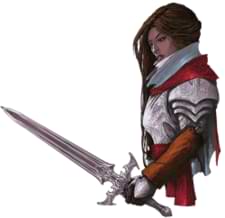 In the past, I’ve had my players use Ireena Kolyana, Ezmerelda d’Avenir, Rudolph van Richten, and other major Ravenloft NPCs as their player characters, rebuilt as pregenerated characters. This is a fun idea, but if you’re not planning on using pregens and want to keep the predatory story of Strahd and Ireena intact, you can cast Ireena as Strahd’s Enemy (see “Fortunes of Ravenloft,” below).
In the past, I’ve had my players use Ireena Kolyana, Ezmerelda d’Avenir, Rudolph van Richten, and other major Ravenloft NPCs as their player characters, rebuilt as pregenerated characters. This is a fun idea, but if you’re not planning on using pregens and want to keep the predatory story of Strahd and Ireena intact, you can cast Ireena as Strahd’s Enemy (see “Fortunes of Ravenloft,” below).
In this scenario, Ireena has already been spirited away to Castle Ravenloft. She may be in need of rescuing, Princess Zelda-style, or she may be mounting a desperate escape of her own. Either way, she uses veteran statistics and appears somewhere in the castle based on your tarokka reading.
The Mists Constrict
The Mists of Ravenloft constrict tightly around the master’s castle, preventing all living creatures from exiting the castle grounds, even using magical means. Spells and effects that teleport creatures out of the castle (such as some effects of the brazier in area 78), instantly fail.
The mists form a wall of opaque fog just beyond the gate towers (area J), and otherwise surrounds the castle’s outer walls at a range of 100 feet. See the “Walls of Ravenloft” map.
Character Creation
I recommend creating characters using the array or point buy, and allowing them to choose one piece of nonmagical armor of their choice (plus a shield, if desired), two nonmagical weapons of their choice (or three weapons, if they are dual-wielding), plus 100 gp to purchase other adventuring gear and a single rare magic item of their choice. I would recommend screening which magic items they take. Items that are particularly powerful against vampires (such as a sun blade can make this scenario very easy, so use your best judgment.
See “Choose your Difficulty” to see what level the characters should be.
Choose Your Difficulty
You can make this adventure easier or harder by changing the level of your characters. Strahd von Zarovich may be a CR 15 vampire, but the legendary artifacts of Ravenloft possess incredible power. If your party is skilled (or lucky) enough to find all three artifacts, it’s possible that with good strategy, even a party of 5th-level characters can defeat Strahd.
A party seeking a hard adventure should play 6th-level characters, a medium adventure caters to 8th-level characters, and an easy attack on the castle can be accomplished by 10th-level characters. Start from this baseline, and adjust according to party size and time limit.
Party Size. This adventure is balanced around a party of 4–5 characters. For every character you add to the party above 5, each character starts 1 level lower. For example, a party of 6 characters on a medium-difficulty adventure should each be 7th level. Likewise, every character you remove from the party below 4, each character gains 1 level.
Time Limit. This adventure is balanced around a 4-hour time limit (plus the time it takes to fight Strahd). For every 2 hours you add to this time, each character starts 1 level lower. For example, a party of 5 characters on a medium-difficulty adventure with a 6-hour timer should each be 6th level. For every 1 hour you detract from this time, each character starts 1 level higher.
Character Death and 'Losing' the Adventure
What happens if a character dies? That’s entirely up to you. Odds are, your players don’t want to sit idly at the table with a torn-up character sheet while the rest of their friends struggle through the adventure, minus one player. Here are some alternatives to character death:
- Casual Revival. When a character would die, they instead fall unconscious and gain 1 level of exhaustion.
- Gothic Revival. When a character would die, they instead fall unconscious and gain a permanent lingering injury.
- Casual Permadeath. When a character dies, their player must make a new character, who is introduced at any time before the next encounter.
- Gothic Permadeath. When a character dies, their player must make a new character of one level lower than their last character, who is introduced at any time before the next encounter.
The only situation in which the characters lose the adventure is if the entire party is killed at once. There’s just no coming back from that.
Fortunes of Ravenloft
There are three powerful artifacts which can defeat Strahd scattered throughout the realm of Barovia. Unfortunately, your players do not have the luxury of wandering all over Barovia, they can only explore Castle Ravenloft itself. The location of these items are determined by a random tarokka reading, which prevents players from memorizing the exact location of the artifacts. It’s an excellent way to make this adventure replayable in future years!
If you want, you can simply do a tarokka reading as prescribed in Curse of Strahd and consider any artifacts drawn outside of the castle “unobtainable,” adding a level of randomized difficulty to the adventure. I’m not a fan of that. When I run a Ravenloft one-shot, I use a modified version of the tarokka drawing in Curse of Strahd that removes locations outside of the castle. You’ll need either an actual tarokka deck or a modified deck of standard playing cards.
Before the game begins, you’ll want to separate your tarokka deck into the High Deck and the Low Deck. The first three cards are drawn from the low deck, and determine the location of the three artifacts capable of defeating Strahd. The first card determines the location of the Tome of Strahd. The second card determines the location of the Holy Symbol of Ravenkind. The third card determines the location of the Sunsword, the fourth card determines the location of Strahd’s enemy, and the fifth card determines the location of Strahd himself.
Variant: Empowered Tome of Strahd
In Curse of Strahd, the Tome of Strahd possesses no magical powers. If you wish to make finding the tome more exciting, you can have the tome grant the following trait to anyone who attunes to it.
Bearer of Strahd’s Truth. While attuned to the Tome of Strahd, you have advantage on saving throws made to resist Strahd’s spells and effects. If you succeed on a saving throw against Strahd’s Charm feature, Strahd takes 22 (4d10) psychic damage.
The Low Deck
First, separate your tarokka deck into the High Deck and the Low Deck. The Low Deck is usually larger, but it’s been modified for this adventure to remove results outside of the castle. This modified Low Deck consists of the following cards:
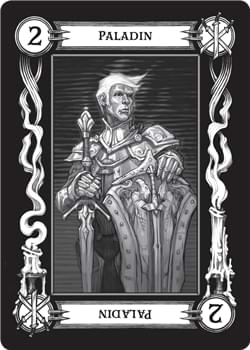
- The Paladin (2 of Spades)
- The Mercenary (4 of Spades)
- The Dictator (8 of Spades)
- The Warrior (10 of Spades)
- The Transmuter (1 of Clubs)
- The Necromancer (8 of Clubs)
- The Merchant (4 of Diamonds)
- The Miser (9 of Diamonds)
- The Shepherd (4 of Hearts)
- The Anarchist (6 of Hearts)
- The Priest (10 of Hearts)
The High Deck
The High Deck consists of the following cards; if you’re using a standard deck of playing cards, the High deck is comprised of both Jokers, and the Jack, Queen, and King of each suit:
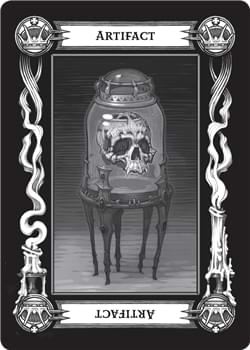
- The Artifact (Joker 1)
- The Beast (Jack of Diamonds)
- The Broken One (King of Diamonds)
- The Darklord (King of Spades)
- The Donjon (King of Clubs)
- The Seer (Jack of Clubs)
- The Ghost (King of Hearts)
- The Executioner (Jack of Spades)
- The Horseman (Joker 2)
- The Innocent (Queen of Hearts)
- The Marionette (Jack of Hearts)
- The Mists (Queen of Spades)
- The Raven (Queen of Clubs)
- The Tempter (Queen of Diamonds)
The Card Reading
With the decks thus separated, you are prepared to do a tarokka reading and randomize the assorted treasures of Ravenloft, as well as the location of Strahd’s enemy and the vampire himself. If this is your first time running Ravenloft, you may wish to perform the card reading in private ahead of time so that you can prepare for these locations instead of taking notes on the fly.
I recommend reading the Fortunes of Ravenloft section of Curse of Strahd at least once in full if you intend to perform the card reading for your players as a prologue to the adventure. This card reading could take many forms; see “Starting the Adventure,” below.
The Artifacts. The first step of the reading is fairly simple. Draw three cards from the Low Deck, and compare them in order to the treasure locations table in Curse of Strahd. Set these cards aside.
Strahd’s Enemy. Next, draw one more card from the Low Deck and compare it to the treasure locations table in Curse of Strahd, just as before. I always cast Ireena Kolyana as Strahd’s enemy and give her veteran statistics, and the card you draw from the Low Deck determines where Ireena is within Castle Ravenloft. She is either captured or fighting for her life against Strahd’s minions.
Strahd’s Location. Finally, draw a single card from the High Deck and compare it to the Strahd’s location in the castle table in Curse of Strahd. This determines where in the castle Strahd lurks when he is not antagonizing the characters.
Starting the Adventure
Do you want to start this adventure with a dramatic inciting incident that urges the characters to explore the castle? Or do you want the characters to begin their exploration of Castle Ravenloft solemnly, with dread and caution hanging over every room?
Personally, I prefer the explosive beginning. Here’s one way:
The characters are all in a carriage racing towards Castle Ravenloft. Lightning streaks through the sky and thunder rumbles all around them. They are traveling at this breakneck pace with legendary vampire hunter Rudolph van Richten, after he gathered them in a last-ditch effort to kill Strahd von Zarovich. He frantically explains what he has learned to them, and displays the tarokka cards and their cryptic clues. Then, as the carriage crosses the rickety bridge to Castle Ravenloft, a gargoyle swoops from the sky and tears Van Richten from the cart and the two plummet over one thousand feet into the gorge beneath the castle.
The carriage careens into courtyard of Castle Ravenloft and crashes as the horses fall mysteriously dead. The characters are hurled from the carriage into the courtyard. As they rise, muddy and soaked through, a massive and ghostly apparition of Strahd appears before them. He cackles at their misfortune and raises an hourglass filled with blood-red sand. He looks down upon them and says:
“I am the ancient. I am the land. I am Count Strahd von Zarovich. Gaze upon me and tremble, foolish hunters. The walls of Castle Ravenloft are my domain, and here, I reign supreme. You wish to hunt me down? So be it. We are but four hours from planar midnight. I grant you four cosmic hours to explore the castle, uncover its mysteries, and confront me." Strahd turns over the hourglass and the sands begin to trickle into the bottom bell. "But when the sands of time run out, so too will your lives. Welcome to Castle Ravenloft. Welcome… to your doom!”
Strahd cackles, and his apparition and his voice fade into the mist as the doors of Castle Ravenloft swing open behind him. The characters stand in the Front Courtyard (area K1), and the door opens into the Entry (area K7). Let the games begin.
Ending the Adventure
In Curse of Strahd, Strahd’s death marks the climax of the adventure. The ending is how the rest of Barovia begins to rebuild after the tyrant’s death, and the fates of the characters, Ireena, the spirits of Sergei and Tatyana, and so forth. In this abridged version, Strahd’s death is probably the end. Because this adventure strips out a lot of the deliciously gothic melodrama to streamline the experience, there isn’t much character drama to resolve in the wake of Strahd’s death. In my experience, the best way to end this adventure is to describe Strahd’s death in extravagant detail, then stand and declare “congratulations!” and then pull over the candy bowl and cool down with your friends for a bit.
Of course, that assumes your party killed Strahd. If they TPK’d before they could do that, well… bring that candy bowl anyway. They might need a little pick-me-up. Happy Halloween!
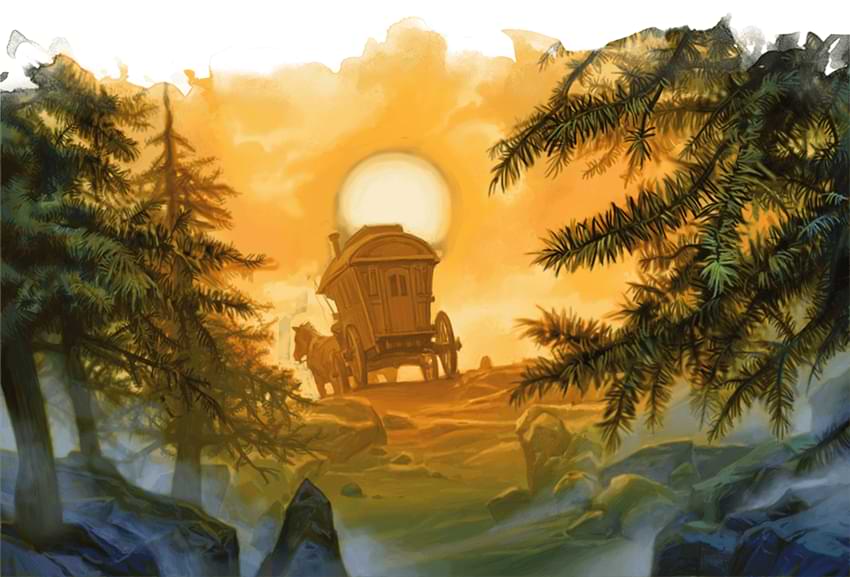
James Haeck (@jamesjhaeck) is the lead writer for D&D Beyond, the co-author of Waterdeep: Dragon Heist, Baldur's Gate: Descent into Avernus, and the Critical Role Tal'Dorei Campaign Setting, a member of the Guild Adepts, and a freelance writer for Wizards of the Coast, the D&D Adventurers League, and other RPG companies. He lives in Seattle, Washington with his fiancée Hannah and their animal companions Mei and Marzipan.








-
View User Profile
-
Send Message
Posted Oct 29, 2018Need to remember this for next years extra life campaign. This year I’m running the tomb from ToA.
-
View User Profile
-
Send Message
Posted Oct 29, 2018I ran my Halloween game this past weekend but I wish I had seen this first!
-
View User Profile
-
Send Message
Posted Oct 29, 2018Amazing article on "adbridging" module james! The article clearly shows what is the most important aspects of adventure prep.
-
View User Profile
-
Send Message
Posted Oct 29, 2018This is going to be an exciting edition to my group's Halloween celebration, thanks!
-
View User Profile
-
Send Message
Posted Oct 29, 2018Just a side note: you might want to consider banning the Driftglobe. It is an uncommon item, but is overly powerful against vampires, as our DM had to realise...
-
View User Profile
-
Send Message
Posted Oct 29, 2018I really need a downloadable version of this, this is a wicked idea for running CoS!
-
View User Profile
-
Send Message
Posted Oct 29, 2018Actually, it's not as powerful as you may think. The daylight spell, which a driftglobe can cast, doesn't actually create sunlight. It's misleading, but a 3rd-level spell isn't enough to lock down Strahd. You'll need a spell with "sun" in its name, like sunbeam or sunburst to do that.
-
View User Profile
-
Send Message
Posted Oct 29, 2018I just started another CoS campaign with my little brother because the last one I overstuffed. This one I intend to go faster, but still with plenty of story.
The party includes:
- half-elf hexblade warlock
- goliath totem barbarian
- human light domain cleric
- lightfoot halfling scout rogue
-
View User Profile
-
Send Message
Posted Oct 29, 2018I've been debating a Castlevania-inspired Halloween session and this just solidified it for me. Thanks James!
-
View User Profile
-
Send Message
Posted Oct 29, 2018this was really cool, but would you recommend using some of the subclasses you talked about in prior articles, like hexblade, shadow sorcerer, or monster hunter? I just thought it would be cool to have a more spooky themed party.
-
View User Profile
-
Send Message
Posted Oct 29, 2018Poor Strahd reduced to a single nights merriment. Once the crown prince of evil and horror. Now just a passing speed bump to some groups nightly thrills. Next week: How to role play "Interview with the Vampire" in 2 hrs.
On a serious note. I have been watching a new anime on Crunchyroll lately. Goblin Slayer. Dude its the most D&D thing I have ever seen put to animation. And that includes anything Wizards of the coast has done till now as well. I highly recommend it for those wanting to add a more realistic feel to their games. And help some GMs understand what failing to kill a pack of Goblins really means. Anyways happy tossing plastic everyone. Im off to paint minis and glue stuff to foam.
-
View User Profile
-
Send Message
Posted Oct 29, 2018Would have been nice with some prep time :/
-
View User Profile
-
Send Message
Posted Oct 29, 2018This is freaking brilliant.
And a great way to wrap up my 8 person CoS campaign. The Time limit is definitely something i'm borrowing.
-
View User Profile
-
Send Message
Posted Oct 29, 2018Awesome James! What a great idea and reimagination of how to run Strahd in one go!
We have been playing for months just to get to the castle... if I had seen this to start we may have been just tempted enough to miss a whole lot of fun in the surrounding Barovian countryside and villages. :)
I still just might do the final play session like this. The patronizing pity bite is a peretty sweet add #SOSTRAHD #ThatsSoRAVENloft
-
View User Profile
-
Send Message
Posted Oct 29, 2018This is super awesome!
-
View User Profile
-
Send Message
Posted Oct 30, 2018Looks like fun! Definitely putting this on the list for next year’s game.
-
View User Profile
-
Send Message
Posted Oct 30, 2018We closed our 9 month strahd campaign tonight and it was epic with a huge twist wedding
-
View User Profile
-
Send Message
Posted Oct 30, 2018Would you still have characters level up for finding artifacts, or would that be too time-consuming for this?
-
View User Profile
-
Send Message
Posted Oct 30, 2018Great idea to post a mod for Strahd that allows for revisiting the historic Haloween night adventure experience. I plan to organize this for next year!
-
View User Profile
-
Send Message
Posted Oct 30, 2018Heh, I tried to put together what I called "Castle Ravenloftvania" together last year, but couldn't quite figure out how to adjust the castle to stand alone. Thanks for this!
Also, I like the idea of the Tome giving some kind of edge against Strahd. Whether it's the full adventure or just the castle as a one shot, the Tome being only exposition seemed like it would be a letdown.